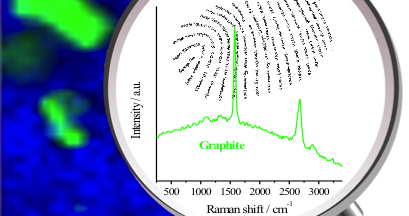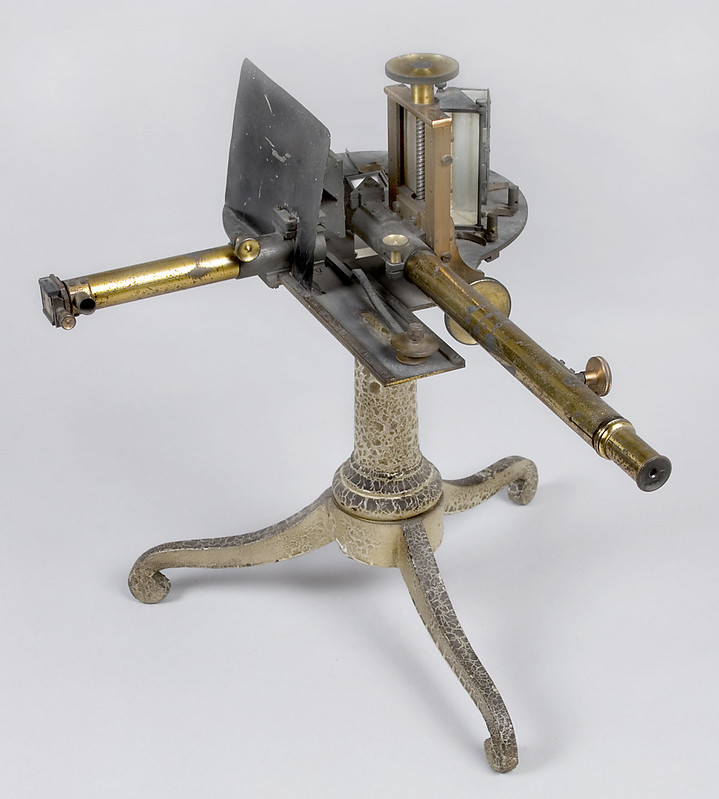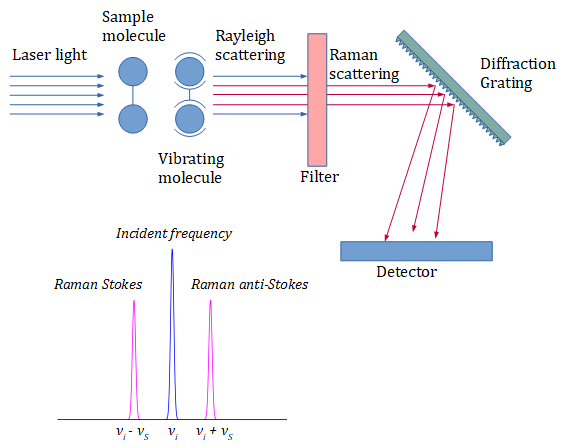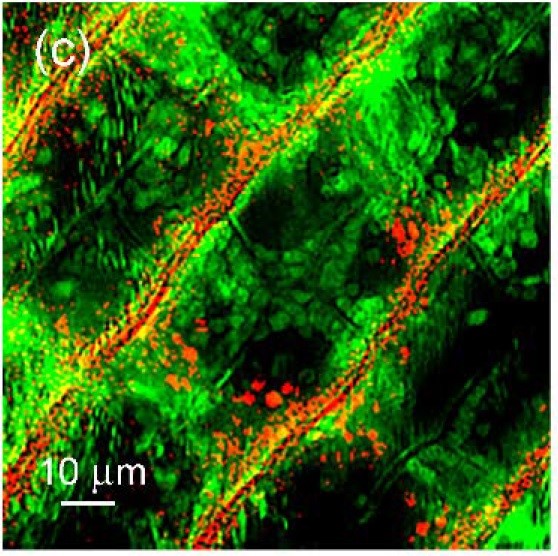
Spectroscopy is a class of analysis methods meant for chemical species identification and concentration measurement, based on emission spectra detection, if irradiated by an adequate light source. Fluorescence-based spectroscopy is one of the oldest spectroscopic techniques. This technique utilizes electron-photon interactions and relies on the absorption of high-energy photons and the subsequent emission of lower-energy, longer-wavelength fluorescence photons, with the energy difference associated with vibrational phonons. Due to the unique level structure of various chemical species, the emitted photons represent unambiguous fingerprints of their presence. Due to the amount of collected fluorescent radiation, concentration evaluation is a straightforward process.

Given the evidence that spectroscopic techniques predate the laser’s invention in the 1960s, in principle, simple, incoherent light sources, such as UV lamps, can excite fluorescence molecular response. However, the development of coherent light sources remarkably improved the performance of these techniques, and enabled new concepts, based on nonlinear processes, with unprecedented high resolutions and sensitivities. Lasers are light sources which potentially emit high-intensity radiation over a very narrow wavelength range. Nowadays, lasers cover most of the spectrum from far ultraviolet to long-wavelength infrared radiation. Different physical concepts for octave-spanning, tunable laser sources have been investigated and developed up to the breakthrough of industrial-grade, commercially available, robust, and reliable devices, providing high intensities over extremely narrow bandwidths. These devices allow the resolution of spectral features less than 1-MHz wide, while the highest-resolution grating spectrometers, based on incoherent broadband sources, could only achieve resolutions hundreds-of-times lower. Atomic lines as narrow as a few Hz (out of a transition frequency of 100s of THz) could readily be observed nowadays with laser spectroscopy.
On the other hand, lasers operating in pulsed regimes exploit 100s-of-nanometers-wide bandwidths to achieve pulse durations as low as a few femtoseconds, including only a few cycles of electromagnetic radiation in the visible or near-infrared spectral window. Apart from enabling time-gated spectroscopy with unprecedented time resolutions, ultrashort laser pulse durations can readily achieve several GW/cm2 peak intensities. Most nonlinear effects occur at these intensities, enabling very high resolution and sensitivity techniques, such as multi-photon absorption spectroscopy, or other Raman-based spectroscopy applications.

For instance, two-photon absorption (TPA), due to its intrinsically nonlinear nature, allows us to achieve much higher resolution and contrast (concerning linear fluorescence excitation) by employing laser sources with double the wavelength and half the photon energy. Also, the operation in a lower photon energy, longer wavelength regime, has the remarkable advantage of reduced photo-toxicity and higher pulse energies available from existing laser technologies for femtosecond pulse generation.
Raman-based spectroscopy, on the other hand, is an entirely different nonlinear technique, relying on the frequency shift experienced by laser radiation incident on a molecule, related to its rotational and vibrational modes. Not being related to electronic transitions, the Raman shift is relative concerning the irradiating wavelength, and therefore, unless pursuing coherent excitation, laser source tunability is not required. Raman-based spectroscopy, being a nonlinear process, usually requires ultrashort pulse generation (e.g., practical TPA set-ups usually require < 300 fs pulse duration). On the other hand, since the Raman gain is generally higher than TPA cross-sections, cheaper and simpler picosecond lasers could be efficiently employed in incoherent Raman spectroscopy. Furthermore, in Raman spectroscopy, the spectral resolution is related to the laser source bandwidth. Therefore, the narrower bandwidths of picosecond lasers represent a remarkable advantage over their femtosecond counterparts. For pulsed laser sources, spectral bandwidths and pulse durations are related by a Fourier-transform relationship, descending from the time-energy Heisenberg uncertainty principle. More precisely, the minimum spectral bandwidth is inversely proportional to the pulse duration. The shorter the pulse duration, the larger the bandwidth for a given temporal pulse profile. For instance, for a pulse duration of ~1 ps at the wavelength of ~1 μm, the minimum FWHM spectral bandwidth is ~1 nm. For pulses ten times longer at the same wavelength (~10 ps), the minimum spectral bandwidth is 10 times narrower (~0.1 nm).

Since the spectral resolution in Raman spectroscopy is related to the spectral bandwidth of the illuminating source, 10-ps-long pulses would potentially provide better spectral resolution than 1-ps-long pulses. On the other hand, longer pulses provide lower peak power for a given average power and repetition rate, and therefore a lower signal and a worse signal-to-noise ratio. An optimal pulse duration of a few picoseconds is generally accepted for typical set-ups as a good trade-off between the different requirements. Moreover, it is important to note that the FWHM spectral bandwidth mentioned above is a minimal value. It is not uncommon for practical lasers to emit pulses with a broader spectrum than the narrowest (transform-limited) theoretical profile due to residual, uncompensated, linear, or nonlinear phase shift.
Typically, ultrafast fiber lasers, while usually representing more compact and rugged technological solutions regarding their solid-state counterparts, are likely to be more affected by poorer spectral properties. This lack of spectral quality is especially true if linear and nonlinear effects are not carefully managed. Poorer spectral profile, if not a critical issue for many different industrial applications, might be a significant drawback for Raman spectroscopy. Bright Solutions‘ NPS laser platform is a new ultrafast picosecond laser series specially tailored for spectroscopic applications by combining compactness and ruggedness of fiber laser technology with the DPSS design’s spectral purity. According to the number and the features of the proprietary amplification stages, it is possible to achieve several power levels at 1064.3nm and its harmonics.

Talk to one of our knowledgeable Product Managers today by emailing us at info@rpmclasers.com or Contact Us with the button below!
Have questions?
 Bright Solutions Srl develops and manufactures state-of-the-art nanosecond and sub-nanosecond DPSS lasers and high brightness diode laser modules. The Company’s focus is directed towards the development of state-of-the-art diode-pumped solid-state laser systems aimed at superior, efficiency, compactness, and reliability. Bright Solutions has vast experience in setting up industrial production and testing lines and in forming professionally skilled personnel for the manufacture of diode-pumped solid-state lasers. Suitable markets include industrial, aerospace, medical, military, and scientific applications. Their diode-pumped solid-state (DPSS) laser portfolio includes sources at 1064nm, 532nm, 355nm, 266nm, 1534nm, 1572nm, and 3.3um.
Bright Solutions Srl develops and manufactures state-of-the-art nanosecond and sub-nanosecond DPSS lasers and high brightness diode laser modules. The Company’s focus is directed towards the development of state-of-the-art diode-pumped solid-state laser systems aimed at superior, efficiency, compactness, and reliability. Bright Solutions has vast experience in setting up industrial production and testing lines and in forming professionally skilled personnel for the manufacture of diode-pumped solid-state lasers. Suitable markets include industrial, aerospace, medical, military, and scientific applications. Their diode-pumped solid-state (DPSS) laser portfolio includes sources at 1064nm, 532nm, 355nm, 266nm, 1534nm, 1572nm, and 3.3um.
The Bright Solutions Group consists of 4 business units: Bright Solutions, Bright Microlaser, Bright Systems, and Bright Aerospace.

 SHIPS TODAY
SHIPS TODAY 